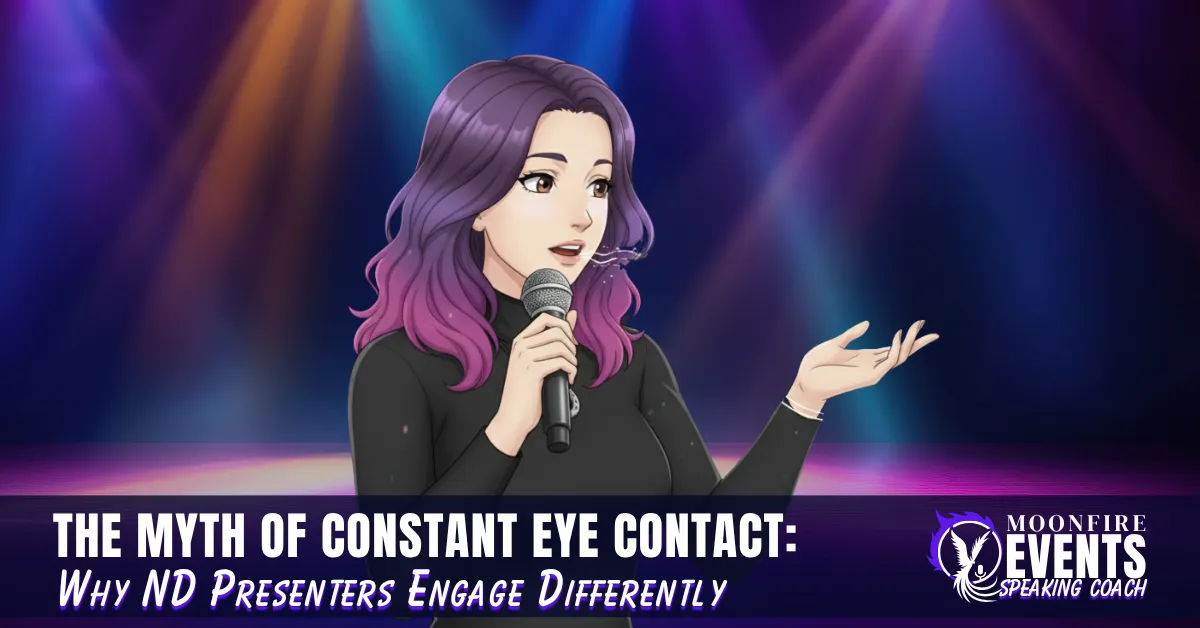
The Myth of Constant Eye Contact: Why ND Presenters Engage Differently
The Myth of Constant Eye Contact: Why ND Presenters Engage Differently
"Look them straight in the eye if you want to be credible."
Sound familiar? It's one of the oldest presentation rules in the book - and it's absolute bullshit.
For neurodivergent women, constant eye contact doesn't make you magnetic. It makes you drained, distracted, or downright uncomfortable. Yet every presentation coach with a shiny blazer still tells you to stare your audience down like you're in a corporate staring contest.
Here's the outlaw truth: eye contact is wildly overrated. Connection doesn't come from how long you lock eyes. It comes from how present you are in your energy, your words, and your body.
And if you've ever felt like a fraud for looking away mid-sentence, glancing at your slides, or letting your gaze drift while you gather your thoughts - this one's for you.
Eye Contact = Overrated
Let's name the elephant in the room: sustained eye contact can be excruciating for ND brains.
For ADHD women, it can derail your train of thought mid-sentence. You're trying to hold someone's gaze while simultaneously tracking your next three points, remembering that killer example, and not losing the thread entirely. Spoiler: the eye contact loses.
For autistic women, it can feel invasive, like a sensory overload you can't switch off. It's not about being shy or awkward. It's about your nervous system screaming that something feels wrong while everyone around you insists it's "professional."
And yet, the "rule" persists.
Why? Because neurotypical presentation culture decided one very narrow version of connection is the gold standard. If you don't try to meet it, you're told you're disengaged, unprofessional, or - my least favorite - "distracting."
But here's the reframe: humans connect in dozens of ways that have nothing to do with eyeballs. Eye contact is just one tool, not the whole damn toolbox.
Real Talk: Why Eye Contact Drains ND Brains
For ADHD brains, maintaining eye contact uses up cognitive bandwidth that could go toward organizing thoughts, tracking your narrative arc, or staying present with your message. For autistic brains, it can trigger sensory overload or feel like an invasive demand that registers as threat rather than connection. Either way, forcing it costs energy you don't get back - energy that could've fueled brilliant storytelling, quick thinking, or authentic rapport.
The kicker? Most audiences don't even notice when you're not making constant eye contact. They notice when your energy shifts, when your voice goes flat, or when you disappear into your own head trying to perform "credibility" instead of delivering value.
Why It Matters: Eye Contact ≠ Connection
When you measure your presence by how well you sustain eye contact, you set yourself up for unnecessary failure.
The costs are real:
Self-conscious presenting. You're so focused on "keeping your gaze steady" that you lose track of your actual message. Your brain splits its attention between what you're saying and where you're looking, and guess what suffers? The content. The energy. The reason you're on that stage in the first place.
Shallow connection. Audiences don't feel more seen because you stared at them longer. They feel seen when your energy is directed toward them, not your inner critic. Connection happens when someone feels like you're speaking to them - not when they feel like you're performing eye contact at them.
Burnout. Forcing ND women into eye contact that feels unnatural depletes energy that could've gone into vibrant storytelling, responsive facilitation, or meaningful interaction. You finish your presentation exhausted not because you gave your all, but because you spent half your energy managing a neurotypical performance standard that doesn't even measure what matters.
But here's what most ND women don't realize: when you force eye contact, your audience can sense the disconnect. They're not reading "confidence" - they're reading effort. And effort reads as uncertainty, even when your message is rock-solid.
The irony? The very thing you're doing to appear credible is undermining your credibility.
Your audience doesn't need you to stare them down.
They need you to be present.
And presence has nothing to do with where your pupils are pointing.
The Real Rules of Engagement (That Actually Work)
So if eye contact isn't the golden ticket to connection, what is?
Let's talk about what audiences actually respond to - the stuff that creates magnetic presence without draining your cognitive reserves or triggering sensory overload.
Energy Direction
Presence isn't about eye contact. It's about energy direction. When your energy is aimed toward your audience - through your body language, your vocal tone, your awareness of the room - they feel it. That's connection.
You can look at your slides, gesture into the air, or glance down to gather your thoughts, and as long as your energy is still with them, the connection holds. In fact, breaking eye contact intentionally can create more intimacy than forcing it. A pause where you look away signals you're thinking, processing, bringing them something real - not reciting a script.
Shared Focus
Some of the most powerful moments in presentations happen when everyone's looking at the same thing - a slide, a prop, a visual, even a question written in the chat. That's not a disconnection. That's a shared focus. And shared focus is connection without the stare.
When you redirect attention to something external, you create a "third point" that takes pressure off the one-on-one intensity of eye contact while still building rapport. You and your audience are experiencing something together. That's intimacy.
Movement and Gesture
Your body tells a story your eyes never could. When you use intentional movement - stepping closer to emphasize a point, opening your arms to invite participation, using your hands to shape ideas in the air - you command attention without ever needing to lock eyes.
Audiences track movement instinctively. It's how we're wired. So when you gesture, shift your stance, or move across the stage with purpose, their eyes follow. You're guiding their attention kinetically, not optically.
And the best part? Movement gives your brain something to do. For ND women, especially those with ADHD, movement can actually help you think more clearly, stay present, and channel nervous energy into purposeful expression.
How to Apply: Authentic Engagement Moves
If eye contact doesn't work for your brain, good news: you've got alternatives that work just as well (if not better).
3 Tactics for Real Connection (No Staring Required)
1. Gesture Framing
Use your hands to emphasize key points - circles, underlines, framing shapes. Your audience follows your movement, not your pupils.
When you say "there are three reasons this matters," frame them in the air with your hands. Draw a box around your key concept. Underline an invisible headline. Your audience's eyes follow your movement, and suddenly you're guiding their attention - not forcing it. You become a visual conductor, orchestrating focus without ever needing to meet anyone's gaze.
Pro tip: If you're on a video call, gestures work even better because they fill the screen and create dynamic visual interest. Your hands become the anchor point, not your eyes.
2. Vocal Variety
Shifts in tone, pace, or volume cue attention far more effectively than prolonged staring. It keeps the brain engaged through sound, not sight alone.
Try dropping your voice to a near-whisper for emphasis, then rising back up for the punchline. Your audience leans in. They're hooked by sound, not stare. Slow down to let a concept land. Speed up to build momentum. Pause to let silence do the heavy lifting.
Vocal variety creates an emotional texture that eye contact never could. It signals confidence, commands attention, and keeps your audience neurologically engaged - all without requiring you to track faces in the crowd.
3. Connection Bridges
Instead of staring down faces, use objects, slides, or even the chat feed as a shared focal point. You redirect attention while keeping presence.
Gesture to your slide and say, "Look at this pattern." Now everyone's looking at the same thing - together. That's a shared focus. That's a shared connection. You've created a bridge between you and them that doesn't require sustained eye contact.
Ask a question and look at the chat for responses. Reference a prop. Point to a visual. Every time you create a "third point" of attention, you relieve the pressure of direct eye contact while deepening engagement.
This is especially powerful for introverted or autistic presenters who find one-on-one eye contact overwhelming but thrive in facilitated, object-oriented communication.
Permission Granted: Connection Without the Stare
Here's your permission slip: you do not need to force eye contact to be seen as confident, credible, or powerful.
Rebel move? Break the stare. Look away on purpose. Glance down while you think. Use your slides as your "eye contact buddy." Build rhythm into your presence the way your brain actually works.
Let your gaze drift to the back of the room. Look just over people's heads. Focus on foreheads or noses instead of eyes if that feels easier. Shift your attention between zones instead of locking onto individuals. These aren't cheats - they're strategies. And they work.
What matters is that your energy stays with your audience. What matters is that you're present in your message, clear in your delivery, and generous with your value. Eye contact is a distraction from all of that if it's costing you cognitive load you can't afford.
Magnetic presence is not about pretending to be neurotypical. It's about leaning into authentic connection strategies that don't drain you. It's about designing your presentations around your strengths - your storytelling, your insights, your ability to make complex ideas feel accessible - instead of trying to retrofit yourself into someone else's rulebook.
The most powerful presenters aren't the ones who follow every rule. They're the ones who know which rules to break and why.
What This Looks Like in Practice
Let's get specific. Here's what rebel presenting actually looks like when you ditch the eye contact obsession:
Scenario 1: You're presenting to a room of 30 people.
Instead of trying to make eye contact with everyone (impossible and exhausting), you divide the room into zones. You look toward the left side for a few sentences, then shift to the right, then the middle. You're not locking eyes with individuals - you're sweeping your presence across the space. The audience feels included. You stay grounded.
Scenario 2: You're on a video call presenting to a screen of tiny squares.
You look at the camera when you want to create a moment of direct address - "Here's what I want you to remember" - but most of the time, you look at your slides, your notes, or even just slightly off-camera. You use your voice and your gestures to hold attention. No one notices you're not staring into the lens because your energy is still fully present.
Scenario 3: You're in a one-on-one pitch or conversation.
You allow yourself to look away when you're thinking. You glance at shared materials - a document, a screen, a notepad. You make brief eye contact when landing key points, but you don't force sustained staring. The conversation feels natural because it is natural. You're not performing. You're connecting.
In every scenario, the common thread is this: you're designing engagement around what works for your brain, not against it.
The Rule We’re Burning
So let's burn this outdated rule to the ground: constant eye contact is not the measure of connection.
You don't need to lock eyes to lock in trust.
You need energy, clarity, and the audacity to show up as yourself - not as some cookie-cutter version of "professional."
ND women don't need to perform neurotypicality to be powerful. We need to stop apologizing for the way our brains work and start designing engagement strategies that leverage our strengths.
Connection happens when you're fully present in your message, generous with your energy, and unapologetic about the strategies that let you show up as your best self. That might include eye contact. It might not. Either way, it's your call - not some outdated presentation coach's.
If this landed like a breath of relief, you're not alone. We're rewriting the rules of presence - and we're doing it without the stare.
Ready to design presentations that work with your brain instead of against it? Let's talk about what's possible when you stop performing and start leveraging what makes you different.
Claudine Land The Virtual Event Whisperer | Founder, Moonfire Events
Where "too much" becomes your greatest business asset
Core Questions
Q: Do you need constant eye contact to be a good presenter?
A: No. Constant eye contact is overrated. Presence comes from energy, clarity, and authenticity - not staring contests.
Q: Why is eye contact hard for ADHD and autistic women?
A: For ADHD brains, sustained eye contact eats up cognitive bandwidth and derails focus. For autistic brains, it can feel like sensory overload or even threat. Either way, it drains energy that could fuel authentic connection.
Q: What actually builds audience connection if not eye contact?
A: Energy direction, vocal variety, gestures, and shared focus points (like slides or props) create deeper, more sustainable connection than forced eye contact.
Q: How can ND presenters replace constant eye contact?
A: Use rebel tactics:
Gesture framing to guide attention.
Vocal shifts to keep brains engaged.
Shared focus on slides or chat as “connection bridges.”
Q: What’s the cost of forcing eye contact in presentations?
A: It leads to self-conscious presenting, shallow connection, and burnout. Audiences don’t read “confidence” - they sense strain.
Q: Can you still be credible without eye contact?
A: Absolutely. Credibility comes from being present in your message and energy. Eye contact is one option, not the rule.



